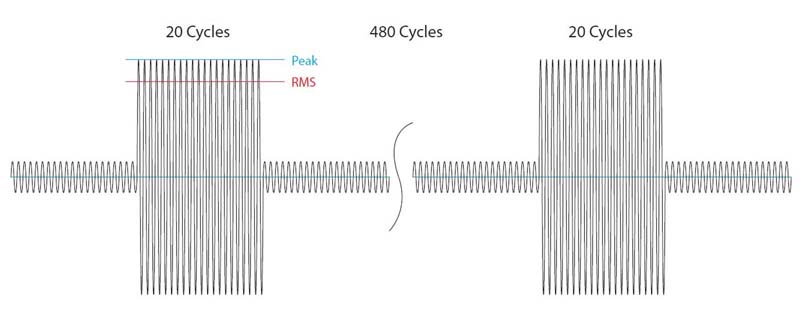
“Peak power” was born and many manufacturers jumped on the bandwagon, yielding to the temptation (and marketing pressure) to publish a higher, more marketable rating that would sell more amplifiers. Better yet, it required no change to the amplifier’s design, just a change on the spec sheet. Putting “peak watts” on the spec sheet did not produce a hotter resistor or louder loudspeaker, it sold more amplifiers.
It should not be surprising that the fine print that stated that it was a peak rating was either omitted or ignored. The public didn’t know to ask and the manufacturer didn’t tell. Both wanted bigger numbers and “peak power” provided them.
Some went as far as to publish “peak-to-peak” power ratings, which are +3 dB (2x power) than a peak rating, and +6 dB (4x power) the RMS rating. So, a 50 watt amplifier (sine wave rating) could be rated at 100 watts peak, and 200 watts peak-to-peak. But no matter what you called it, the load resistor didn’t get any hotter. That’s when the FTC stepped in and forced the industry to clean up its specification practices.
Flash Forward To Present
Most would like to think that in this enlightened, app-driven age where people can be seen sitting in coffee shops and at stop lights continuously absorbing information from their smart phones, that we have moved beyond playing games with rating methods to bolster product sales. Well, generations come and go, but people are still people. Consumers want “more” and manufacturers want to supply it. The ratings game has a modern incarnation that is no less deceptive than the peak power wars of the ‘70s.
The Burst Test
Chances are the largest (and maybe only) rating for a power amplifier that you will find in a brochure or specification sheet is the result of a burst test. Burst testing was developed for cell phones but found its way into the audio world.

In the ‘70s, the amplifier had to actually sustain the sine wave over time into the rated load resistance. The “game” was played with the voltage value used in the power equation. The burst test pulses the waveform, which greatly reduces the stress on the amplifier.
The test waveform for the CEA2006 burst test is shown in Figure 3. The sine wave is full-scale for 20 cycles, and then reduced by 20 dB for 480 cycles, and then continuously repeated. The test frequency is 1 kHz. There is also a 50 Hz version with a different pattern. An amplifier whose output voltage will drop with a continuous sine wave will be able to maintain the full amplitude of the burst waveform.
The amplifier rating is determined by the RMS voltage of the full-scale segment of the waveform, allowing it to masquerade as a continuous sine wave rating. The marketeers of the ‘70s failed to disclose that their power rating used the peak voltage. Today they fail to disclose that their amplifier’s massive power rating is from a burst test.
The burst test has some indisputable merits. I actually like this test as part of an amplifier specification.
—It’s more like music and speech than a sine wave.
—It generates far less heat into my dummy load than a sine wave, so there is less danger of catching the lab on fire.
—It greatly reduces the stress on the amplifier, resulting in fewer blown fuses and thermal failures.
—I can test a “2000 watt” amplifier with a 200 watt dummy load.
Of the battery of tests that we run on power amps, the burst test yields the highest power rating, with the least stress on the amplifier. See the problem?
There are even ways to manipulate the burst test results. One is to simply choose a shorter burst. If 3 or 4 cycles are used instead of 20, then the amplifier will be able to hold its full output voltage into a lower load impedance. The result is a higher power rating.
